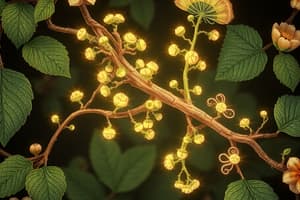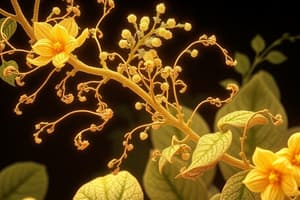Podcast
Questions and Answers
What role do root hairs play in a plant's water uptake?
What role do root hairs play in a plant's water uptake?
- They increase the surface area for osmosis. (correct)
- They store water for later use.
- They create pressure within the xylem.
- They actively transport ions out of the cell.
How does the rate of transpiration change with wind speed?
How does the rate of transpiration change with wind speed?
- It remains constant regardless of wind speed.
- It only depends on temperature.
- It can increase on windy days. (correct)
- It decreases on windy days.
What effect does high humidity have on transpiration?
What effect does high humidity have on transpiration?
- It increases the concentration gradient.
- It has no measurable effect.
- It decreases the rate of transpiration. (correct)
- It enhances water evaporation from leaves.
What primarily drives the movement of water up the xylem in plants?
What primarily drives the movement of water up the xylem in plants?
Which characteristic of stomata is likely to enhance the rate of transpiration?
Which characteristic of stomata is likely to enhance the rate of transpiration?
What happens to a plant when it loses too much water?
What happens to a plant when it loses too much water?
Which of the following factors does NOT affect the rate of transpiration?
Which of the following factors does NOT affect the rate of transpiration?
What is one function of the xylem in plants?
What is one function of the xylem in plants?
What is the primary role of xylem in plants?
What is the primary role of xylem in plants?
How do xylem cells adapt their structure to efficiently transport water?
How do xylem cells adapt their structure to efficiently transport water?
Where is phloem located in the stems of plants?
Where is phloem located in the stems of plants?
What cell process allows water to enter root hair cells?
What cell process allows water to enter root hair cells?
In which part of the plant does water initially enter after passing through root hair cells?
In which part of the plant does water initially enter after passing through root hair cells?
What substance is transported by phloem in plants?
What substance is transported by phloem in plants?
What evidence can be observed to demonstrate that water is absorbed by a plant?
What evidence can be observed to demonstrate that water is absorbed by a plant?
What is the main function of transpiration in relation to xylem?
What is the main function of transpiration in relation to xylem?
Flashcards
Xylem
Xylem
A type of vascular tissue in plants responsible for transporting water and mineral ions from the roots to the rest of the plant.
Phloem
Phloem
A type of vascular tissue in plants responsible for transporting sugars and amino acids from the leaves to the rest of the plant.
Transpiration
Transpiration
The process by which water is taken up by the roots of a plant and transported upwards through the xylem.
Translocation
Translocation
Signup and view all the flashcards
Lignified Walls of Xylem
Lignified Walls of Xylem
Signup and view all the flashcards
Hollow Xylem Cells
Hollow Xylem Cells
Signup and view all the flashcards
Osmosis
Osmosis
Signup and view all the flashcards
Root Hair Cells
Root Hair Cells
Signup and view all the flashcards
Root Hairs
Root Hairs
Signup and view all the flashcards
Active Transport
Active Transport
Signup and view all the flashcards
Stomata
Stomata
Signup and view all the flashcards
Transpiration Pull
Transpiration Pull
Signup and view all the flashcards
Cohesion of Water
Cohesion of Water
Signup and view all the flashcards
Turgor Pressure
Turgor Pressure
Signup and view all the flashcards
Study Notes
Transport in Plants
- Plants have a transport system consisting of xylem and phloem vessels. These vessels transport nutrients between the roots and the rest of the plant.
Xylem
- Xylem transports water and mineral ions from the roots to the rest of the plant (transpiration).
- Xylem cells are adapted for this:
- Thick walls containing lignin: provides strength and support
- Hollow with no cell content: creates space for water transport
- Joined end-to-end with no cross-walls: forms a continuous tube for water flow
- Xylem is located in the middle of roots in an X shape, and on the inside of stems.
Phloem
- Phloem transports sucrose and amino acids (translocation) throughout the plant.
- Phloem cells are living cells.
Position of Xylem and Phloem in Roots
- Xylem is located in the center, shaped like an X.
- Phloem is on the outside of the xylem.
Position of Xylem and Phloem in Stems
- Xylem is on the inside of the stem.
- Phloem is on the outside of the xylem.
- Xylem is on top of phloem in leaves.
Water Uptake
- Water is absorbed by root hair cells via osmosis.
- Water then moves into the root cortex cells, then into the xylem.
- Water moves to the leaves via the xylem as a result of transpiration pull.
- Root hairs have a large surface area for water absorption, thin walls for faster osmosis, and a short diffusion distance.
Transpiration
- Transpiration is the loss of water vapor from leaves.
- Water evaporates from the surface of mesophyll cells, diffuses into interconnecting air spaces, and then exits leaves via stomata.
- Larger surface area, higher number of stomata result in increased transpiration.
- Factors affecting transpiration rate:
- High temperature increases evaporation.
- High wind speed increases water loss.
- High humidity decreases rate because of lower water vapor concentration difference.
- Transpiration pull draws water up the xylem.
- Water molecules are cohesive (stick together), making it possible for water to move up xylem.
- Water cohesion creates a transpiration pull.
Translocation
- Translocation is the movement of sucrose and amino acids to various parts of the plant.
- Occurs in phloem vessels.
- Materials are transported from sources to sinks.
Studying That Suits You
Use AI to generate personalized quizzes and flashcards to suit your learning preferences.




